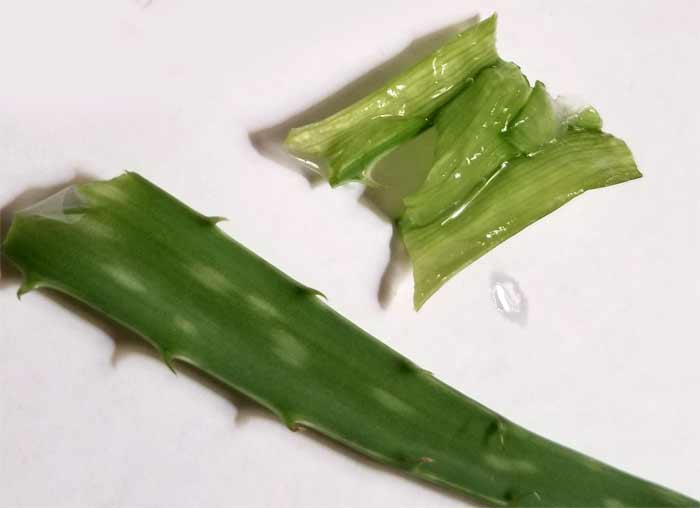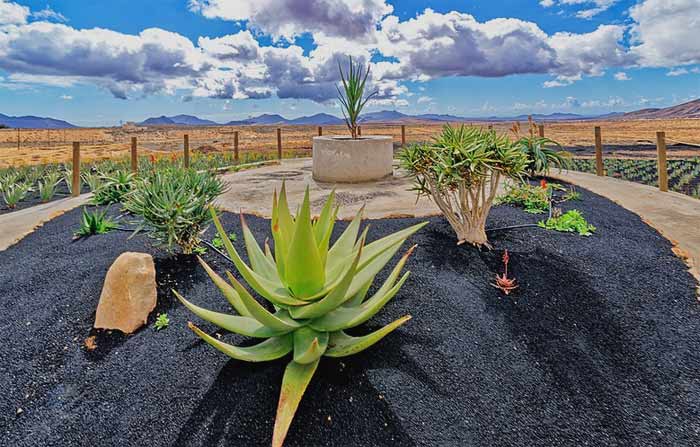Using Aloe Vera in herbal medicine
Aloe Vera (Aloe barbadensis miller) is famous for its healing properties, especially when it comes to treating first degree burns. Often, one application of Aloe Vera gel is enough to stop the pain and start the healing.

Aloe Vera is an amazing natural remedy.
Aloe can treat many conditions, not just burns. Aloe Vera, a bitter herb, soothes burns, promotes bile flow, heals minor wounds, helps expel worms, moisturizes the skin, and can act as a sedative.
It can also help rashes brought on by allergies. Aloe Vera is useful in the treatment of dry skin, and is safe to use on sensitive skin around the eyes.
Aloe Vera is also used as a natural treatment for acne and ringworm.
Aloe can even help get rid of warts. Apply often for best results.

Aloe heals the skin.
Aloe Vera contains enzymes that open pores and slough off dead skin cells. Regular use can greatly improve a sallow complexion.
I split open an aloe leaf, and rub it on my face to refresh my skin.
This easy application works great in the winter when we are indoors with drying heat. The gel also cools the skin in hot summer months and helps heal sunburn.
Aloe Vera is often used in cosmetics, lip balms, soaps, and energy drinks.
Aloe Vera contains enzymes that are responsible for new cell growth, healing, and pain relief.
The plant gel is great for scrapes, skin ulcers, insect bites, rashes, psoriasis, frostbite, eczema, scabies, radiation burns, sunburn, and reducing scar tissue.
When the soft, pulpy leaves are cut or broken, the transparent thick pulp is exposed and should be applied to the affected area while fresh.
As the gel dries, it provides a protective covering, relief from inflammation, and promotes speedy healing.
Aloe as a moisturizer
Aloe helps the skin produce more collagen and elastin fibers while binding moisture to the skin. This is great news for anyone with dry skin, wrinkles, or blemishes.
Applications of Aloe Vera soften the skin and help reduce thick, rough areas on heels and elbows.
It also acts as a mild astringent to tighten pores for a more youthful look.
Aloe is used for sunburn.
If you look closely, the plant world is full of nice surprises. Who would expect the dry desert lands of Africa to produce a moist herbal remedy like Aloe Vera?
Thick Aloe Vera leaves are made up of rich moisturizing gel that soothes and heals.
One of its first medicinal uses was for sunburn. Just cut open and apply the gel to sunburned skin. The cooling effects are felt immediately.
Aloe Vera is one of the most widely used herbal remedies in the world.
Aloe Vera has a long history in herbal medicine.
Known by the Egyptians as the Plant of Immortality, the healing properties of Aloe Vera have been documented by many ancient civilizations including the Greeks.
It was used to heal burns, to cleanse the stomach, and to loosen the bowels.

When burned, reach for Aloe Vera.
Aloe Vera should be growing in every kitchen. When burned by a touching hot pan or other heat source, immediately put the burned area in cold water. Every second counts when stopping the heat that causes tissue damage.
After running cold water over burned area for two minutes, break off a piece of Aloe Vera and apply liberally.
Aloe Vera stops pain, speeds healing, and reduces scarring. In case of severe burns or charred skin, seek professional help.
Aloe Vera is used in colon treatments.
Aloe Vera juice is sometimes taken internally for various digestive problems. It is a natural medicine for colon problems, pancreas problems, and liver diseases, but can also cause diarrhea and vomiting if too much is consumed.
Taking Aloe Vera by mouth causes the intestines to take in more water, which softens the stool. It also also increases mucus and intestinal peristalsis which makes the bowels move.
Take internally only in small doses to avoid cramping. When taking aloe by mouth, be cautious! Taking too much aloe has been linked to hepatitis and other health issues.
Read about the best herbs for constipation.
We don't take Aloe Vera internally, but love to use it on our skin!
Other uses for Aloe Vera
Aloe Vera is often used as a home remedy for arthritis. Rub the gel gently on aching joints.
Cayenne pepper or a few drops of rosemary essential oil may be added for extra strength.
Aloe Vera helps increase the body’s uptake of oxygen. It is even used in the treatment of skin cancer, HIV, hemorrhoids, and varicose veins. Aloe Vera is also useful in the treatment of radiation burns on the skin.
Studies are currently underway to test the medicinal properties of Aloe Vera. Preliminary results suggest that the plant may be useful as a natural remedy for building immunity.
Aloe Vera as a natural remedy
Aloe Vera contains many healing substances including vitamins, antioxidants, live enzymes, minerals, fatty acids, amino acids, hormones, saponins, and sugars.
They work together to stimulate the production of new skin cells, thus speeding up the healing process. Applications of Aloe Vera gel also help to reduce scaring, but should not be used on deep wounds or surgical incisions.
Aloe Vera is a succulent that spreads by offsets.
Leaves are thick and fleshy, usually light to gray-green in color. Aloe Vera can survive extreme growing conditions including everything from arid deserts to humid, tropical jungles (although it cannot tolerate standing water or freezing temperatures).
Aloe is found wild in dry parts of Asia, Africa, North America, and South America.
Aloe is in the same plant family as lilies, tulips, and garlic. There are over 500 aloe species!
Aloe Vera plants are often grown indoors. Water aloe plants only when dry and make sure that the plants get plenty of indirect sunshine.
Aloe Vera likes morning sun, but all day sunshine can be too much. Aloe will grow in poor soil but must have good drainage and temperatures above freezing.
Grow your own Aloe Vera so you have it when needed.
This video shows how to pot and take care of your new aloe plant.
*Do not use Aloe Vera internally during any stage of pregnancy. Always test on a small area first, before using on the face or large areas of skin. Do not apply Aloe Vera to surgical incisions, 3rd degree burns, or deep wounds.
High doses of Aloe Vera taken internally can cause severe cramps and vomiting. If taking aloe internally, do not use it for over two weeks. Always consult with a healthcare professional before using any herbal remedy.
Sources:
https://www.nccih.nih.gov/health/aloe-vera
https://www.ncbi.nlm.nih.gov/pmc/articles/PMC2763764/
Blessings to you and yours!
Thanks so much for reading my blog. Jan.

*Note - the information on this website has not been evaluated by the Food and Drug Administration.
© 2005-2024 website design and content by Janice Boling